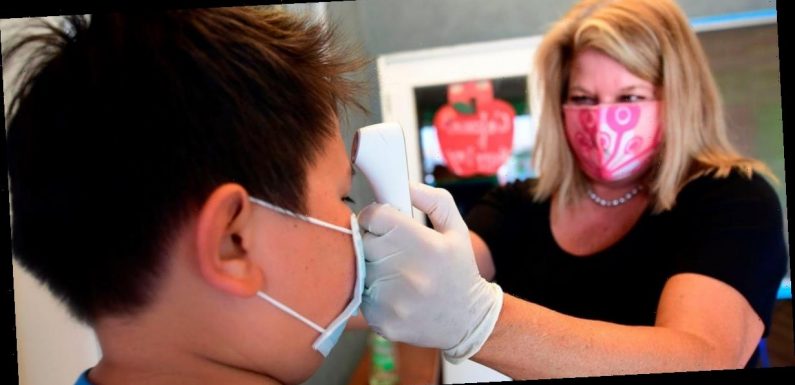
- A coronavirus variant first found in California is more contagious and deadlier than the original strain, an early study suggests.
- The study, first reported by Science, hasn’t been formally scrutinized by other experts in a peer review.
- Some experts say more data is needed before the strain is considered dangerous.
- Visit the Business section of Insider for more stories.
The coronavirus variant first found in California is more infectious than the original virus strain, more likely to be associated with severe illness, and partially resistant to antibodies, an early study suggests.
“The devil is already here,” Charles Chiu, an infectious diseases physician and sequencing expert at University of California, San Francisco (UCSF), who led the study, told the LA Times. “I wish it were different. But the science is the science.”
Other experts say more data is needed before conclusions are drawn about the variant.
The variant in California comprises two slightly different mutated forms of the virus, called B.1.427 and B.1.429. It is also called CAL.20C, using another naming system. It was first found in California in July, and has now been detected across the US and in other countries, including Australia, Denmark, Mexico and Taiwan, according to GISAID.
The study authors said that the new variant “should likely be designated a variant of concern warranting urgent follow-up investigation,” Science reported Tuesday. A variant of concern is a variant that has been risk assessed by experts for concerning features, such as being highly infectious, making people sicker, or escaping the immune response produced by vaccines.
The study has not been posted online yet or formally scrutinized by experts in a peer review.
Eric Topol, founder and director of the Scripps Research Translational Institute, said on Twitter that there was “a problem” with labeling the variant “dangerous” without the study being published, and while COVID-19 cases, hospitalization, and deaths were falling despite the variant being widespread.
“If I were a reviewer, I would want to see more data from more infected people to substantiate this very provocative claim,” David O’Connor, viral sequencing expert at the University of Wisconsin, Madison, told Science.
Chiu and his colleagues examined 2,172 virus samples collected from 44 of California’s 58 counties between September 1 and January 29. At the start of September, they found no cases of B.1.427/B.1.429. By late January, the variant accounted for nearly a quarter of cases sequenced. From the data, Chiu and his colleagues estimated that the number of cases caused by the variant was now doubling every 18 days, The New York Times reported.
Bruce Walker, an immunologist and founding director of the Ragon Institute in Boston, told the LA Times that it was hard “to disentangle” all the different factors that contribute to spread, including travel, holiday gatherings, and restaurant dining.
“I’m increasingly convinced that this one is transmitting more than others locally,” William Hanage, an epidemiologist at the Harvard T.H. Chan School of Public Health, told The New York Times. “But there’s not evidence to suggest that it’s in the same ballpark” as B.1.1.7, the variant first identified in the UK and now spreading throughout the US.
Variant has a key mutation
The study authors identified some possibilities as to why the variant first detected in California, B.1.427 /B.1.429, could be more infectious than other variants in the state. First, they found that there was twice the amount of virus on nasal swabs from those who were infected with B.1.427 /B.1.429, than those who weren’t. This could mean people with the variant carry more virus particles, and are more likely to pass on the virus to others.
Secondly, the variant in California has a mutation, called L452R, in its spike protein — the part of the virus used to infect cells. The authors engineered a coronavirus with the L452R mutation, and found it was able to infect human lung tissue at least 40% more readily than other variants, and was three times more infectious. L452R hasn’t been seen in the existing variants of concern.
Thirdly, the scientists found that the antibodies produced by the body to fight infection worked 50% less well against B.1.427 /B.1.429 than the original coronavirus variant. The effect was less pronounced than for the variant first discovered in South Africa, which reduced the antibodies’ efficacy to one-sixth of their usual levels.
If antibodies work less well, it could mean there’s increased risk of reinfection, and vaccines could be less effective. However, another pre-print study has found that the variant first found in California produced a similar antibody response to the original coronavirus, however.
Ciui and his team also said that the variant could be more deadly.
The team studied 324 medical records from UCSF clinics and its medical centre, and found those carrying the variant were 4.8 times more likely to be admitted to intensive care and more than 11 times more likely to die, compared to those infected with other variants, Science reported.
Ciui’s team said that they adjusted for differences in age, gender, and ethnicity when they number crunched. The numbers were small though, and it was not possible to tell whether more people died due to the B.1.427 /B.1.429 variant itself, or whether overwhelmed hospitals and possible suboptimal care as a result contributed to their deaths, the authors said.
Healthcare Explained:
Telehealth Industry
Value-Based Care
Senior Care & Assisted Living Market
Medical Devices & Wearable Tech
AI in Healthcare
Remote Patient Monitoring
Get the latest coronavirus business & economic impact analysis from Business Insider Intelligence on how COVID-19 is affecting industries.
Source: Read Full Article